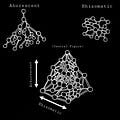The paradoxical structure of a cryptocurrency – one which seems decentralized, rhizomatic, anti-authoritarian yet is, in reality, the exact opposite – can be seen as antithetical to many of the botanical organisms which Deleuze and Guattari make an analogy to in their concept of the rhizome. The express power of these bizarre, seemingly rhizomatic (and yet somehow arborescent) structures comes as a result of their paradoxical nature. One requires more than a surface-level interrogation into them in order to understand their true nature as a threat to anti-authoritarianism as opposed to its ally.
We can see this phenomenon as the inverse of many of the rhizomatic botanical organisms Deleuze and Guattari evoke in their work as a reference point. As pointed out by Jathan Sadowski in Too Smart, rhizomatic clonal colonies such as the “Trembling Giant” in Utah are primary examples of the botanical rhizome which Deleuze and Guattari are referencing. Ironically, the trembling giant appears upon a surface level analysis as being a large group of individual aspen trees, as if it is arborescent. In reality, this massive, ten-thousand-year-old organism is a collection of many trees all connected to each other through a subterranean root system. It is interesting to note how the cryptocurrency structure, or what I will refer to as a “crypto-rhizome,” is the exact opposite of this. It appears upon a surface-level glance as if it is a large, decentralized organism predicated upon a multiplicity of different non-essential connections, yet if one were to dig deeper, they would note the essential, singular point in this organism which, when cut off, would kill the entire thing.
*
Therefore, the crypto-rhizome is the exact opposite of the botanical rhizome, yet it carries with it many similarities. On a surface level glance, the botanical rhizome may allow one to assume that it is simply a forest of different (yet dependant) organisms, where each one can be killed if one severs the essential connection in each (that is, if one cuts off the trunk of each of the aspen trees in the trembling giant). A larger, structural analysis of these botanical rhizomes shows, of course, how much harder it is to kill this organism. Each aspen tree must be separated at the root level from the others (which in reality are not “others” but merely a different element of the same organism) then each tree must subsequently be killed.
*
On the other hand, the crypto-rhizome appears at a surface level analysis as being rhizomatic and therefore makes it impossible to target an essential point in the organism which, when severed, would destroy it. It does this specifically to hide the actually existing single, essential point which all data, life, meaning, etc. (depending on where this concept is mobilized) must flow through in order for the entire structure to function. The elements of the crypto-rhizome which appear as if they are rhizomatic are a result of a sort of pseudo-criticism of the top-down structure that is unable to destroy it and becomes subsequently integrated within it. With cryptocurrencies, the single essential point (ironically) becomes the very same point that fiat and other currencies flow through: the state apparatus. While it may have been an attempt to break down this top-down structure, it is entirely unable to do that and is still predicated upon the central point.
The crypto-rhizome masks its true nature for the same reason that the botanical rhizome masks its nature; for survival. On a surface level analysis, this leads one to disassemble the crypto-rhizome how one ought to disassemble the trembling giant and vice versa. The crypto-rhizome may appear as if one should disassemble it by attacking the multiplicity of non-hierarchical spontaneous, non-essential connections that make themselves obvious upon a surface level analysis (just as one ought to properly disassemble a rhizome). It makes it seem as if this is the case, of course, to hide the essential and non-rhizomatic top-down connections which, when severed, would actually destroy the crypto rhizome. Without the destruction of these points, the crypto-rhizome will not be destroyed.
*
This is how a movement like QAnon, for instance, ought to be conceived. Many were baffled that QAnon became even more popular following (1) the large-scale de-platforming of QAnon accounts on social media websites and (2) the removal of Donald Trump from office. People were baffled by this because they view the QAnon movement as a rhizome and not a crypto-rhizome. “Surely the absurd and sporadic structure of the QAnon movement,” they thought, “could not possibly survive all of its prominent members being banned, its centrally important websites being taken down, its primary raison d’etre (that is, of Trump remaining in office) being proven wrong.” This is an analysis that necessarily requires one to think of the Q movement as if it is structured like a rhizome, contingent upon the connections made online between the individual Q believers and fellow-minded right-wing conspiracy nuts on Twitter, YouTube, Facebook, etc.
This analysis ignores the essential, centralized point in which, in reality, the Q movement necessarily flows through; that is, Donald J. Trump. Trump functions, in many ways, as a despotic signifier for the Q movement. By this, I mean that all meaning and value must fundamentally flow through and relate intimately to Donald Trump for those who believe in Q to make it legible. If a world event cannot be understood in some way in relation to Donald Trump, then this world event is not worth thinking about; it may have even been planted as a distraction to get people to stop focusing on what is really important (that is, things that one can make relate in some way to Donald Trump). It is, therefore, no surprise that Q believers looked at the coup in Myanmar, which was launched using false claims of a rigged election, as a sign that something similar would somehow happen in America.
The baking process, which is the essential process of interpretation for the Q supporters, may be seen as analogous to the mining process of a cryptocurrency. In fact, a cryptocurrency known as “Tezos” actually refers to its mining process as “baking” and those who verify the blockchain transaction processes as “bakers” instead of miners. The baking process (of the Q believers) may appear as if it is decentralized and autonomous, not necessarily referencing any source of authority directly. This is how many Q believers can imagine themselves as “free thinkers.” This is another tricky effect of the crypto-rhizome. Many who even participate within its structure do not realize the top-down, authoritarian nature of the connections they are making.
*
Importantly, Q believers do not get their belief that Trump is secretly working with military intelligence to stop a Satanic shadow cabal of pedophile elites sent to them by the White House or the State Department. The truth of the world for Q believers is fundamentally related to the autonomous process of baking Q drops and interpreting world events to fit into some relationship with Trump’s supposed grand plan to stop the Satanic shadow cabal. Like crypto-mining, this process is entirely decentralized and not directly overseen by a source of authority. Yet, this mining/baking process contains a production of truth that is necessarily contingent upon top-down structures. Just as the mining process that creates the public crypto ledger is contingent upon the state to enforce private property, so to is the baking process contingent upon Donald Trump as a source of authority.
Trump serves as the despotic signifier for the baking process, yet this does not imply that he is in charge of how QAnon believers will see him or how they will bake world events in relation to him. One of the reasons why QAnon is such an absurd belief system which has no real reference to Trump’s personal goals and desires (by this, I mean that he desires to make more money, to be more well-liked, etc. and they see him as desiring to take over in a military coup) is because one existing as a despotic signifier does not necessarily imply that one has absolute control over one’s society.
We can imagine the example of Hirohito during Imperial Japan as an excellent representation of the potentially limited powers that the despotic signifier has (an example given to me by Twitter mutual @JimothyBurg1ar). Hirohito had very minimal control and capacity to act during Imperial Japan. Yet, essentially all acts of war, military decisions, governmental policy choices, etc., were done under the guise of relating to his authority. All crucial actions were fundamentally related to him, his personal interests, security, decision-making, etc. yet he had no actual influence. If Hirohito had been removed from power, this would have fundamentally altered Japanese society. He has no real capacity to influence politics, yet his position is essential, and all meaning-making must essentially relate to him.
It is important not to give in to the liberal “great man theory” of history when describing figures like Trump and their role as a despotic signifier for QAnon. Hegel refutes great man theory, ironically, very similar to Deleuze and Guattari in imagining that Napoleon was “history on horseback.” For Hegel, Napoleon had represented the zeitgeist of the Napoleonic Wars, where all world history had diverged into him, relating to him and his decisions. But that did not mean that Napoleon was in charge of world history during this time. In fact, becoming as world historically significant as Napoleon is likely not a desirable trait (as one can see in how Napoleon’s life ended). This is one way of imagining how world historically significant Trump is as a figure while also somehow viewing him as not having a meaningful effect on the creation of something such as QAnon propaganda. Trump, of course, enables the Q conspiracy by not denouncing it. Yet, it is not a surprise to see a conspiracy theory like QAnon attach itself to an individual who, given the opportunity, would not denounce it for personal gain.
The specific sites of meaning creation (the baking process) related to QAnon are not (in the immediate sense) constructed by a top-down state apparatus. They reference Trump as a despotic signifier, yet this does not mean he is in control of it. This marks a significant break from how fascist propaganda is usually disseminated.
As noted by Adorno and Horkheimer, fascist propaganda takes a similar model to the culture industry. Mass culture is produced analogously to factory production (it is organized in a top-down structure by corporate executives, where the individual is conditioned to be simply handed a heavily commodified, relatively intellectual simple product as central to their cultural life). Adorno and Horkheimer argue that fascist propaganda is produced following the exact same relationship to the culture industry and the culture industry introduces the individual to this relationship and makes fascist propaganda more effective. This can help reasonably explain why so many movie references are crucial to the QAnon worldview; their fascist propaganda literally references products of the culture industry instead of simply working analogously to it. Contrastingly to this traditional model, though, QAnon is not produced using the top-down industrial relationship seen in traditional fascism.
*
Many may respond that they disagree with this position and assert that Q is probably an op by either the CIA or Russia, invented to divide American politics or embolden the right etc. This account would meaningfully imply that the fascist propaganda of Q is, in fact, identical in nature to the fascist propaganda of old. This belief falls into the inverse misunderstanding of those who imagined that Q accounts getting banned would end the QAnon movement. Instead of imaging QAnon to be entirely decentralized, rhizomatic, they instead assert that it is entirely top-down, arborescent. One will gravely misunderstand the Q movement if they ignore either its partially rhizomatic elements or its overall arborescent structure. QAnon is not an operation by a state intelligence agency simply because it is too ridiculous. No competent government could ever imagine that such an absurd story (with such an absurd introduction on 4Chan) would ever even dream of being remotely as successful as QAnon has been.
*
The Q ethos has generally been constructed in a way that is very dissimilar to a majority of fascist propaganda; it has not been directly built upon a central ministry that espouses particular positions that the fascist masses then come to believe. It was created entirely autonomously of these central mechanisms of propaganda (which still certainly exist) and espouse beliefs that in certain situations even contradict the central propaganda apparatus.
In a certain sense, we can imagine that this is a product of the post-industrial age, where the division of labour centred around factory production is exported to countries in the periphery to be replaced primarily by service jobs. The gig economy has a far more analogous structure to the production of contemporary fascism than factory production for a multitude of reasons. The most important one being the transition away from a Foucaldian disciplinary society towards a Deleuzian society of control.
“Felix Guattari has imagined a city where one would be able to leave one’s apartment, one’s street, one’s neighbourhood, thanks to one’s (dividual) electronic card that raises a given barrier’ but that card could easily be rejected on a given day or between certain hours; what counts is not the barrier but the computer that tracks each person’s position – licit or illicit – and effects a universal modulation” – Deleuze, Postscript on the Societies of Control
Within the Foucauldian disciplinary society, one is organized analogously with the factory, where a disciplinary mechanism of power takes the unmolded collective of semi-skilled proletarian labour and moulds it to fulfil a specific task on the long and monotonous industrial division of labour to increase profits. We can compare the disciplinary society to how traditional fascist propaganda is produced.
Within the society of control, one is organized alongside the model of the gig economy. Deleuze had written in 1992 that the society of control functioned alongside the corporation, but he had predicted this phenomenon early enough to not see its primary locus in our contemporary era, which is still corporate but nevertheless far more specific. Different institutions of power join together in a collaborative effort to define the individual by a large set of data points (their consumption habits, their location, their credit score, their GPA, their criminal record). If certain elements of the data set deem one “undesirable” (e.g., you are sometimes late on rent, you have a criminal record, you said something bad about capitalism online), the algorithms which manage the data sets collected about you collectively work to deny you access to particular elements of society.
It is only able to do this based upon the pure atomization involved in “platform-based” business models in which everything is not owned by the individual but rented out by large corporations as a “service.” One rents their car, their house, the music they listen to, the shows they watch, means of production they labour on etc. This extends to services such as uber, which deeply atomizes individual work not by moulding the individual through disciplinary power on an assembly line but by renting their labour out to others and enforcing the completion of that labour through a GPS-based surveillance apparatus.
*
As a result of this, power does not mould the individual based upon a Foucauldian disciplinary panoptic model (which threatens that surveillance is at any time possible); power moulds the individual through the literal constant application of surveillance by a technopolitical security apparatus.
The crucial similarity in structure to a movement such as QAnon comes from the fact that this apparatus is dispersed and seemingly rhizomatic. Unlike the traditional industrial factory's disciplinary power, it works to permanently observe the individual and collect data on them in increasingly intimate ways that abstract the subject while simultaneously reifying them.
“We can see the rapid growth of a technological rhizome through the ongoing effort to connect everything together into integrated, expansive, smart systems… The rhizomatic smart systems spread and creep, becoming massive and sprawling while reproducing the interests and imperatives they represent. Uprooting a large rhizome is a difficult task. You can try to sheer parts of it, but more stems will emerge elsewhere from the mass of roots.” - Jathan Sadowski, Too Smart
Sadowski’s account of digital capitalism and its relationship to the Deleuzian society of control within Too Smart is excellent. He highlights the nature in which the society of control appears as if it is rhizomatic, yet in reality, it is not. This society, of course, cannot be predicated upon a purely rhizomatic data structure as it is embedded within a techno-capitalist surveillance state. The crypto-rhizome is the emerging data structure that attempts to envelop all else through an acceleration of capital.
*
As the society of control, along with the increased power of corporate data accumulation, mass surveillance, atomized gig economy jobs, renting everything one requires instead of owning it, etc. becomes more significant and outshines the disciplinary society, we will begin to see more and more of our world flow through these crypto-rhizomes. In many ways, they are far less stable than that of the purely arborescent structure (as highlighted by the inability of QAnon to meaningfully organize itself politically and cryptocurrency being far less stable than fiat-based regulated currencies). But in many ways, they are much stronger than the traditional arborescent structure.
For the most part, the crypto-rhizome comes from an attempt to critique the traditional arborescent structure, which does not have the capacity to go far enough. We can see this in the example of blockchain-based cryptocurrencies attempting to critique the top-down authoritarian structure of a central bank, or QAnon attempting to critique the “powers that be” who uphold the oppressive global political system, or even in “platform-based” corporations who are ushering in the society of control attempting to “disrupt” older corporate models. In each case, we can imagine that this attempt at criticism makes our own criticism (which works to abolish the entire structure) far more difficult. QAnon, for instance, already attempts to “market” itself as an opposition to the status quo, which will fight against the “elites” and allow for the “common man” to thrive. It, therefore, may distract and mislead individuals who would otherwise be sympathetic to a meaningful critique of the state and capitalism.
This is why, firstly, it is extremely dangerous to describe something like QAnon as being “partially correct” as a result of it saying something about the existence of a group of “elites” who control society. If our analysis is to be truly rhizomatic, if it is to truly work to deconstruct arborescent, top-down structures instead of being integrated within them, we cannot give a single point of credit to these crypto-rhizomes. To do so is like giving credit to the silicon valley tech billionaires who are “disrupting” old capitalist markets by transitioning us to the society of control. It would seem ridiculous, in my opinion, to credit these tech billionaires for admitting the old capitalist social formation is “faulty,” given that their solution is to make the situation even worse (just as QAnon does).
*
To properly destroy these new crypto-rhizomatic social formations necessitates one at least understanding their nature, lest we attempt to destroy them as if they are either purely rhizomatic or purely arborescent (and fail just as one would fail to attempt to destroy the trembling giant merely by cutting down its individual aspen trees). As Deleuze writes: “It is up to [young people] to discover what they’re being made to serve, just as their elders discovered, not without difficulty, the telos of the disciplines. The coils of a serpent are even more complex than the burrows of a molehill.”













QAnon and the Crypto-Rhizome (2/2)